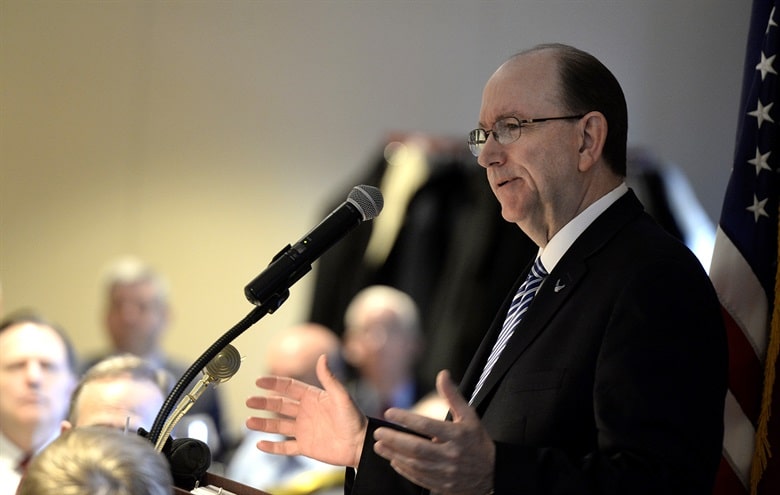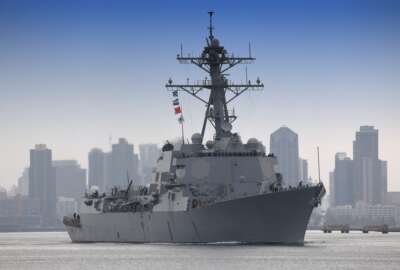
Air Force moves ahead with headquarters-level merger of intel, IT functions
The Air Force will merge the three-star positions that oversee intelligence and IT into a single position, known as the A2/A6. Lt. Gen. Dash Jamieson is expect...
The Air Force is pressing ahead with a planned restructuring of its headquarters staff elements in charge of IT, cyber and intelligence issues. The service has already picked a prospective leader for the combined organization.
The Air Force has decided to merge the offices of its deputy chief of staff for Intelligence, Surveillance and Reconnaissance (A2) with its deputy chief of staff for Information Dominance (A6).
Preliminary plans for the new organization — dubbed the A2/A6 — were first publicly floated last August by Gen. David Goldfein, the Air Force chief of staff, who said at the time that the service saw a need for tighter integration of its decision making in the “information domain.”

But the Air Force has formally decided to move forward with the combination, and plans to nominate Lt. Gen. VeraLinn “Dash” Jamieson — the current A2 — to lead it, said Matt Donovan, the undersecretary of the Air Force.
The A6 slot has historically served as the Air Staff’s resource sponsor for communication systems, but it has been vacant since Lt. Gen. Bill Bender retired in August 2017.
For years, the position had been dual-hatted to also serve as the Air Force chief information officer. But in an August 2018 memo, Air Force Secretary Heather Wilson severed that connection and designated Donovan as the CIO.
Bill Marion, a career civil servant, served as the acting Air Force CIO until the mantle was handed to Donovan in August. Since then, his official title has reverted to deputy CIO, Air Force officials said.
Donovan said the A2/A6 combination is related to the CIO change, and that the decision to vest him with the CIO’s policymaking and oversight authorities makes sense, considering that he also serves as the Air Force’s chief management officer and directly oversees the service’s new chief data officer.
“We’re integrating these functions to spearhead a digital Air Force initiative,” he told a meeting hosted by the Air Force Association’s Mitchell Institute. “Data will power next-generation combat, so we must control and manipulate massive volumes of information to out-think and outmaneuver our opponents. We want every system in our air force to connect, to share, and to learn. We are implementing several reforms to realize this vision and to bring our disaggregated systems into the digital age.”
Outsourcing the IT grunt work
All of the organizational changes come at the same time the Air Force is engaging in a much broader rethinking about which of its IT functions should be performed by airmen, and which are better handled by industry.
For nearly two years, the service has been contemplating an approach — called enterprise-IT-as-a-service — that would outsource much of the day-to-day grunt work involved in managing its networks. Last fall, it issued an other transaction agreement to AT&T to pilot the approach at several bases.
Donovan said part of the reasoning is that it would let the Air Force devote its own personnel to military-unique functions such as cyber defense and offense, instead of using them for routine network administration jobs that private firms are more than capable of performing.
“We have a whole bunch of people that we call cyber operators that are really just doing that communications job — running cables, outdoor plant, indoor plant, that kind of thing. In one fell swoop a few years ago, we said, ‘They’re all cyber warriors’ because cyber was the name du jour at that time,” he said. “But we’ve refined, and decided they’re probably not all cyber operators … But instead of just blowing up the career field, enterprise-IT-as-a-service may be an opportunity for us to repurpose a lot of those if we go through more of an industry type model, where we have somebody else take care of everything behind the socket plate and we just take care of what’s between there and the computer on the desk.”
The Air Force is not the only military department that’s reconsidering its approach to IT governance.
Last week, Navy Secretary Richard Spencer said he is contemplating the creation of a new assistant secretary for information management, an appointed position that would oversee cybersecurity, IT and data issues for the Navy and Marine Corps.
The Navy Department is different from its Army and Air Force counterparts, in that it contains two services that also have their own CIOs.
But at the military headquarters staff level, Donovan said the Navy had proven the combination of the “2” and “6” functions can work well: It first created an N2/N6 a decade ago.
Related Stories
But also this week, one of that service’s largest commands — Army Materiel Command — announced a similar combination, becoming the first Army organization to merge its G2 and its G6. The intent is to bring all of the command’s intelligence, cyber and security experts into one organization, AMC said in a release.
“Traditionally, a G2 would not have cyber as a central part of its mission,” said Daniel Bradford, a civilian senior executive who is leading AMC’s new G2/G6. “But we are establishing defensive cyber capabilities by ensuring the cyber division has critical intelligence to inform our actions and protect the logistics enterprise.”
He said that the intent is to combine intelligence and technology to defend the “battle space.”
“In all of AMC’s missions — logistics, supply, research and development, contracting and others — there are key systems and data sets that must be defended in cyberspace to guarantee data integrity and system availability while protecting sensitive information vital to our mission,” Bradford said.
Copyright © 2024 Federal News Network. All rights reserved. This website is not intended for users located within the European Economic Area.
Jared Serbu is deputy editor of Federal News Network and reports on the Defense Department’s contracting, legislative, workforce and IT issues.
Follow @jserbuWFED





